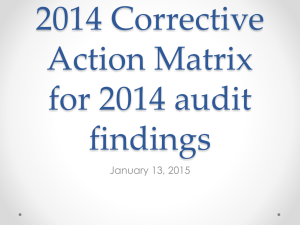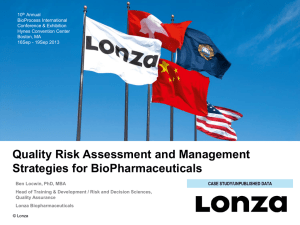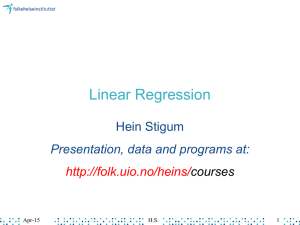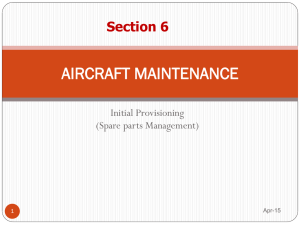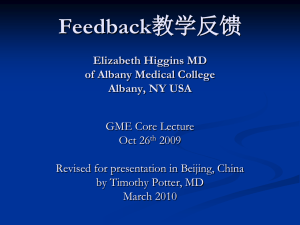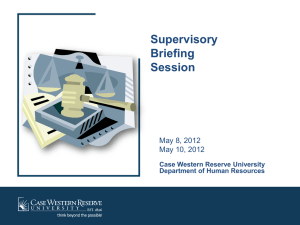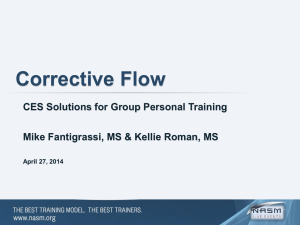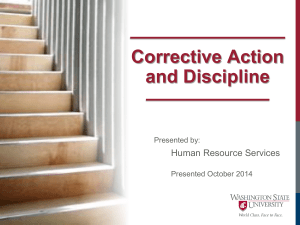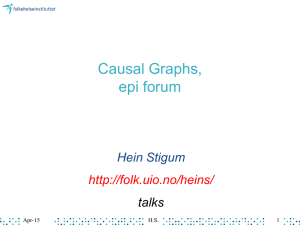10A CASS and Reliability
advertisement
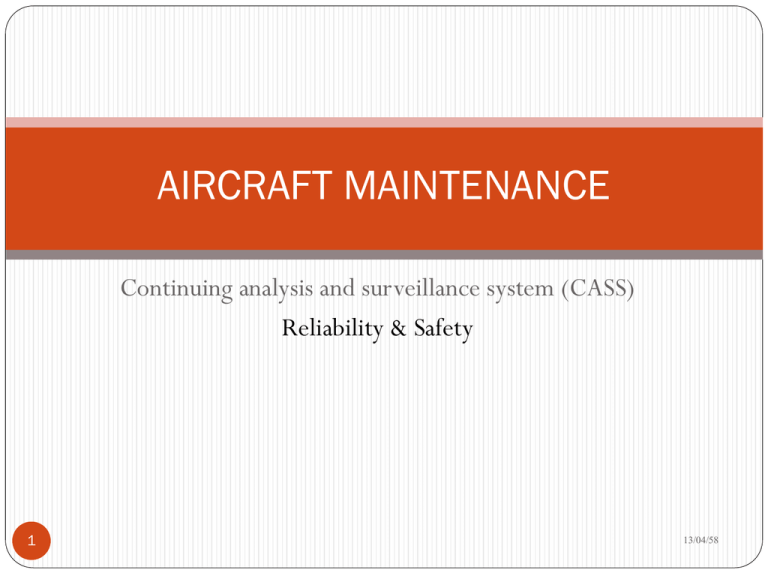
AIRCRAFT MAINTENANCE Continuing analysis and surveillance system (CASS) Reliability & Safety 1 13/04/58 Reliability Definition “The probability that an item will perform a required function, under specified conditions without failure, for a specified amount of time.” 2 Main Approaches Looks at Whole Operation : Dispatch Reliability Looks at Maintenance Program : Reliability Program 2 13/04/58 Reliability Term Reliability Overall Reliability Component Reliability Process Reliability Maintenance Program Reliability Types of Reliability (4 types) 3 Statistical Reliability Historical Reliability Event-oriented Reliability Dispatch Reliability 13/04/58 Reliability Event-oriented Reliability Concerned with one-time events such as bird strikes, hard landing, in-flight shutdowns, or others accidents or incidents, which these are events that do not occur on a regular basis. Each occurrence must be investigated to determine the cause and to prevent or reduce the possibility of recurrence of the problem. 4 13/04/58 Reliability Dispatch Reliability (DR) DR is a measure of the overall effectiveness of the airline operation with respect on-time departure. It is a simple calculation based on 100 flights. DR involves more than just maintenance Dispatch delays should look at the whole operation. On-time departure means that the aircraft has been “pushed back” from the gate within 15 minutes of the scheduled departure time 5 13/04/58 Reliability Dispatch reliability 6 13/04/58 Reliability Reliability Department Responsibility of monitoring failure rates, removals of A/C systems and components to measure the effectiveness of the overall maintenance program 7 Data Collection Preliminary Investigation Issue Alert Notices Monitor Results 13/04/58 Reliability Reliability Program A set of rules and practices for managing and controlling a maintenance program Monitor the performance of the vehicles and their associated equipment and call attention to any need for corrective action Monitor the effectiveness of corrective actions Provide data to justify adjusting the maintenance intervals 8 13/04/58 Reliability Elements of a Reliability Program Data collection Problem area alerting Data Display Data analysis Corrective actions Follow-up analysis Monthly report 9 13/04/58 Reliability Data collection 10 Flight time and cycle Cancellations and delay over 15 minutes Unscheduled component removals Unscheduled engine removals In-flight shutdowns of engines (IFSD) Pilot reports or logbooks Cabin logbook Component failure (shop) Maintenance check package findings Critical failures ▪ Data collection ▪ Problem area alerting ▪ Data Display ▪ Data analysis ▪ Corrective actions ▪ Follow-up analysis ▪ Monthly report Reliability Problem area alerting An alerting system Identify those areas where the performance is significantly different from the normal Alert level is based on a statistical analysis Alert level is set at one to three standard deviations above the mean rate Alert level is referred as UCL (Upper Control Limit) Additional calculation that can be made to smooth the curve (3 months average) and help eliminate “false alerts” 11 ▪ Data collection ▪ Problem area alerting ▪ Data Display ▪ Data analysis ▪ Corrective actions ▪ Follow-up analysis ▪ Monthly report Reliability Problem area alerting (cond.) Setting and adjusting alert levels Recommended that alert levels be recalculated yearly UCL (Upper Control Level) 3 months Offset Control Chart 13 ▪ Data collection ▪ Problem area alerting ▪ Data Display ▪ Data analysis ▪ Corrective actions ▪ Follow-up analysis ▪ Monthly report Reliability Data analysis Reliability Department a preliminary analysis to determine if the alert is valid If valid, on-alert condition is sent to engineering for a more detailed analysis Engineering Department Troubleshoot the problem Issue EO (Engineering Order) Recommendations to the Airline Maintenance Program Review Board (MPRB) 14 ▪ Data collection ▪ Problem area alerting ▪ Data Display ▪ Data analysis ▪ Corrective actions ▪ Follow-up analysis ▪ Monthly report Reliability Corrective actions Modifications of equipment Correction to line, hangar or shop processes or practices Disposal or defective parts Training of mechanics Addition of maintenance tasks to the program Decreased in maintenance intervals Completion of the corrective action is noted in the monthly reliability report 15 ▪ Data collection ▪ Problem area alerting ▪ Data Display ▪ Data analysis ▪ Corrective actions ▪ Follow-up analysis ▪ Monthly report Reliability Follow-up analysis Verify the corrective action taken was indeed effective Reflected in decreased event rates If no significant change, corrective action should be reanalyzed 16 ▪ Data collection ▪ Problem area alerting ▪ Data Display ▪ Data analysis ▪ Corrective actions ▪ Follow-up analysis ▪ Monthly report Reliability Monthly report Working tool for maintenance management Picture of what problems are encountered 17 ▪ Data collection ▪ Problem area alerting ▪ Data Display ▪ Data analysis ▪ Corrective actions ▪ Follow-up analysis ▪ Monthly report Reliability Reliability Program Document Every aspect of the reliability must be documented in an official document signed be MPRB chairman and approved be the regulatory authority Include: Detailed discussion Methods used to determine alert levels Rules relative to changing Define MPRB activities and Responsibility Monthly Report Format Submitted to FAA for approval 18 ▪ Data collection ▪ Problem area alerting ▪ Data Display ▪ Data analysis ▪ Corrective actions ▪ Follow-up analysis ▪ Monthly report Safety 19 Apr-15 Traditional Safety Management Loss Control - Correction approach Loss control is the tools for - Prevention - Reduction - Elimination Cause of incident and accident is -Unsafe Action -Unsafe Condition 20 Apr-15 Loss Causation Model 1. Loss - Loss of Direct cost - Loss of Indirect cost 2. Incident 3. Immediate Cause - Low standard action and Low standard condition 4. Basic Cause - Personal Factor and Job Factor 5. Lack of Control 21 Apr-15 Loss Control Management Process 1. 2. 3. 4. 5. 22 Identification of Work Set Standard Measurement Evaluation Commendation and Correction Apr-15 Modern Loss Management 1. Source of Loss - People - Equipment - Material - Enviroment 2. Loss Control systems - International Safety Rating System (ISRS) -US - Total Loss Control Management-UK 23 Apr-15 Modern Safety Management Modern Safety Management – Prevention, Risk Assessment and Risk control approaches Modern Safety Management is Loss Control Management Modern Safety Management used POLC framework 24 Apr-15 Modern Safety Management There are 4 approach to Modern Safety Management 1. Management concept 2. Management information system 3. Performance standard 4. Measurement and Evaluation system 25 Apr-15 System Safety 26 Apr-15 FAA - Safety Risk Matrix FAA Advisory Circular No. 120-92, Introduction of Safety Management Systems for Air Operators 27 Apr-15 FAA - Safety Risk Matrix Unacceptable (Red). Where combinations of severity and likelihood cause risk to fall into the red area, the risk would be assessed as unacceptable and further work would be required to design an intervention to eliminate that associated hazard or to control the factors that lead to higher risk likelihood or severity. Acceptable (Green). Where the assessed risk falls into the green area, it may be accepted without further action. The objective in risk management should always be to reduce risk to as low as practicable regardless of whether or not the assessment shows that it can be accepted as is. This is a fundamental principle of continuous improvement. Acceptable with Mitigation (Yellow). Where the risk assessment falls into the yellow area, the risk may be accepted under defined conditions of mitigation. An example of this situation would be an assessment of the impact of a non-operational aircraft component for inclusion on a (MEL). Defining an Operational (“O”) or Maintenance (“M”) procedure in the MEL would constitute a mitigating action that could make an otherwise unacceptable risk acceptable, as long as the defined procedure was implemented. These situations may also require continued special emphasis in the safety assurance function 28 Apr-15 General Safety Rules Fire prevention & protection Hangar deluge systems Fall prevention and Protection Storage and handling Smoking regulation Hangar safety Shop safety Line safety 29 Apr-15 Hand Signal 30 Apr-15 Safety Management System ICAO has established a framework for an SMS that incorporates four basic components and 12 elements as shown here: 31 Apr-15 MEDA Corrective Actions THE END


